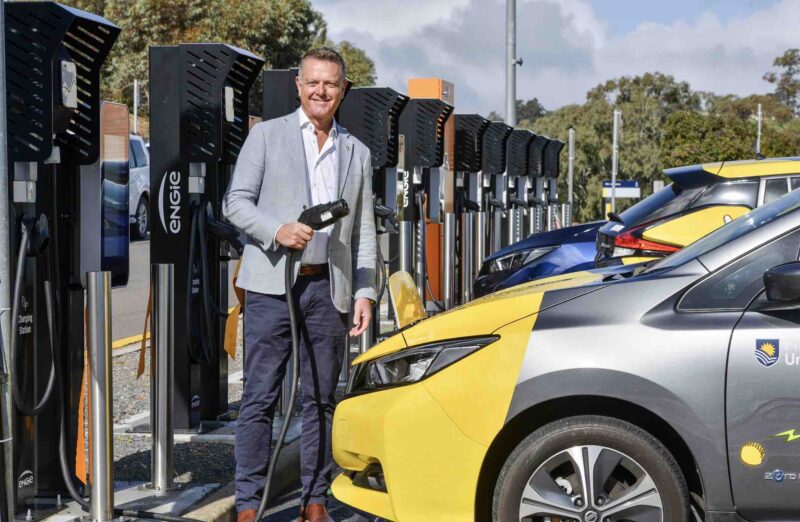Australia’s biggest array of bi-directional vehicle-to-grid (V2G) charging technology has been unveiled at South Australia’s Flinders University as part of a landmark EV charging hub.
A joint venture between French energy giant Engie and Flinders University will feature 10 vehicle-to-grid charging stations, along with another 15 AC chargers for use by Flinders staff and students, and another four charging DC fast charging bays that will be open to the public.
The V2G chargers are a landmark event for Australia, and are designed to play a role in providing back-up and key services to the South Australian grid when needed, and will show how EVs can be harnessed as “batteries on wheels” to support the state’s wind and solar dominated grid in periods of peak demand.
The V2G charging bays can charge and discharge electricity to the grid, creating a virtual power plant (VPP) at the university. It can only be used by compatible EVs – which at this stage is limited largely to Nissan Leaf EVs – but which will eventually include most other EVs as they adopt the technology.
“Somebody needs to go first, somebody needs to trial it,” says Flinders University chief operating officer Mark Gregory. “We need a way to store renewable energy, and this is brilliant solution that also solves the transportation emissions problem.”
South Australia, which already sources more than 70 per cent of its grid demand needs from wind and solar, expects to host about 170,000 EVs on its roads by 2030, and up to 1 million EVs will be integrated into the electricity system over the next 20 years.
“More and more electric vehicles will be hitting our roads in years to come as we travel towards net zero emissions,” said state energy minister Tom Koutsantonis. “With trials like this investigating the possibilities for broad use of this technology we can be confident we are on the right track.”
Koutsantonis said EVs have batteries much bigger than those installed in houses.
“Imagine driving to work, charging in a car park, going home and then plugging your motor vehicle into the house, offsetting your use at home,” he said at a media event.
“This is literally the advance we are looking for. This is groundbreaking and revolutionary. It’s not just about saving on petrol, it is changing the way we think about energy.”
The two rapid DC chargers at Flinders University (rated at 150kW each, able to service two cars at a time at up to 75kW each) will use the Chargefox operating platform, and will feature time-of-use pricing brackets.
These will vary throughout the trial period to test how pricing can be used to encourage smart charging use during periods of high renewable energy generation or low demand.
The trial will generate 12-months of data and provide a range of knowledge sharing to inform and encourage further investment in integrated smart charging infrastructure and uptake of EVs, in particular for large fleets.
The trial is part of a $3.2 million government program that is generate over $4.5 million in private investment in EV
charging infrastructure, and will deliver around 140 smart EV charging bays across a mixture of public and commercial fleet sites around the state.
Flinders University vice-chancellor Professor Colin Stirling said the campus already runs on 100 per cent renewable energy, including 20 per cent generated on campus through its solar arrays.
“With inspiring education and research into solar and battery technologies we’re supporting South Australia’s transition to a renewable world, underpinned by incredible research growth of 140 per cent in just five years,” he said in a statement.
The head of Engie in Australia and New Zealand, Rik De Buyserie, said the the program signals the huge uplift in demand and increasing awareness of the extended benefits of transitioning to an EV fleet.
“The integration of renewable energy, EV charging and demand management systems better matches renewable output to a site’s demand, reduces emissions and puts downward pressure on electricity prices,” he said.
See also: Batteries on wheels: EVs can deliver huge amount of low cost storage for wind and solar

Giles Parkinson is founder and editor of The Driven, and also edits and founded the Renew Economy and One Step Off The Grid web sites. He has been a journalist for nearly 40 years, is a former business and deputy editor of the Australian Financial Review, and owns a Tesla Model 3.

